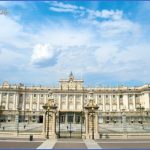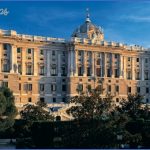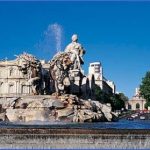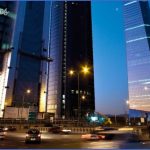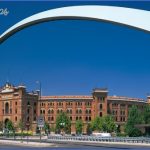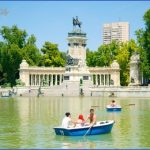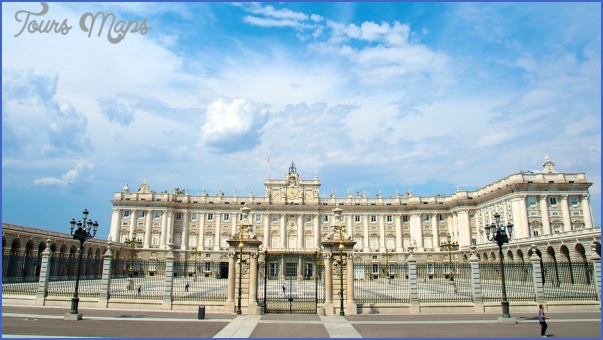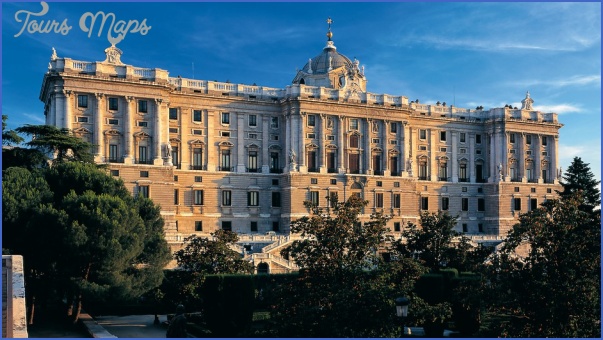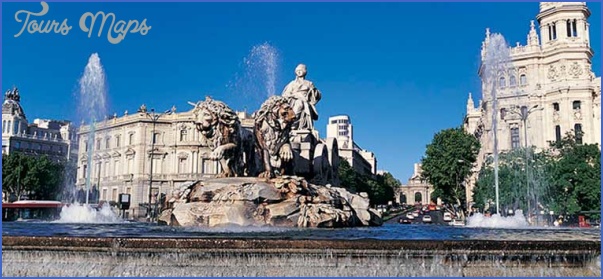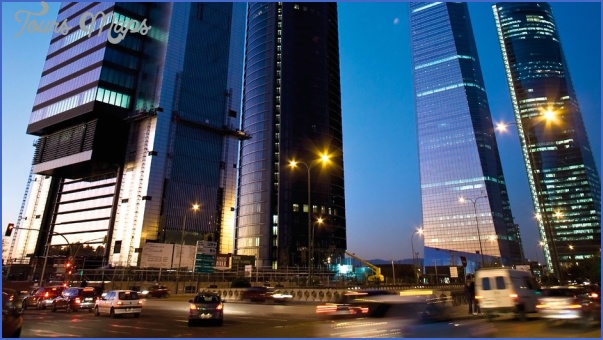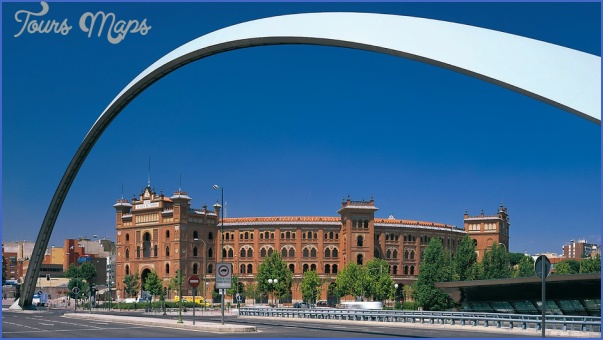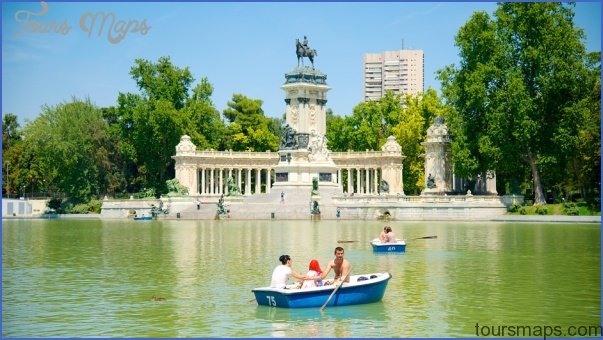Madrid Vacations
PALACIO REAL
The luxurious Palacio Real lies at the western tip of central Madrid, overlooking the Rio Manzanares. Felipe V commissioned Giovanni Sachetti to replace the Alcazar, which had burned down in 1734, with a palace that would dwarf all others he succeeded. Today, the unfinished palace is only used by King Juan Carlos and Queen Sofia on special occasions. The palace’s most impressive rooms are decorated in the Rococo style. The Salon de Gasparini, site of the king’s ceremonial dressing before the court, houses Goya’s portrait of Carlos TV and a Mengs ceiling fresco. The Salon del Trono (Throne Room) also contains a ceiling fresco, painted by Tiepolo, that outlines the qualities of the quintessential ruler. The Biblioteca shelves first editions of Don Quixote. Also open to the public is the Real Armeria (Armory), which displays the armor of Carlos V and Felipe II. (M: Sol. From Pta. Sol, take C. Mayor and turn right on C. Bailen. Open Apr.-Sept. M-Sa 9am-6pm, Su 9am-3pm; Oct.-Mar. M-Sa 9:30am-5pm, Su 9am-2pm. ‚7, students ‚3.30. Tours ‚8. W free for EU citizens.) Next door to the palace is the Cathedral de Nuestra Senora de la Almudena, begun in 1879 and finished a century later. The cathedral’s modern interior stands in contrast to the gilded Palacio Real. (M: Sol. From Pta. Sol, go down C. Mayor and it’s just across C. Bailen. Open daily 9am-9pm. Free.)
PLAZA DE ORIENTE. A minor architectural miscalculation was responsible for this sculpture park. Most of the statues here were designed for the palace roof, but because they were too heavy (and the queen had a nightmare about the roof collapsing), they were placed in this shady plaza instead. Treat yourself to pricey coffee on one of the elegant terrazas that fringe the plaza. The Jardlnes de Sabatlni, just to the right as you face the palace, is the romantic’s park of choice. (From Pta. Sol, take C. Arenal to the plaza. Free.)
PARQUE DE LAS VISTILLAS. This park was named for its gorgeous vistillas (views) of Palacio Real, Nuestra Senora de la Almudena, and the surrounding countryside. Be careful at night, as it can be dangerous. (In PI. Gabriel Miro. Facing the palace, turn left on C. Bailen, and then right on C. Don Pedro into the plaza.)
HUERTAS
The area east of Sol is a wedge bounded by C. de Alcala to the north, C. Atocha to the south, and Po. Prado to the east. Huertas’s sights, from authors’ houses to famous cafes, reflect its artistic focus. Home to Cervantes, Gongora, Quevedo, Calderon, and Moratin in the Siglo de Oro (Golden Age), Huertas enjoyed a fleeting return to literary prominence when Hemingway frequented the neighborhood in the 1920s. Plaza Santa Ana and its terrazas are the center of this old literary haunt. Casa de Lope de Vega is the home where the prolific playwright and poet spent the last 25 years of his life and wrote over two-thirds of his plays. The highlights include the simple garden described in his works and the library filled with crumbling, aromatic books. Among the more interesting tidbits revealed on the required tour are the tangible signs of affection Vega would leave for his young daughters. (C. de Cervantes 11. With your back to PI. de Santa Ana, turn left on C. del Prado, right on C. de Leon, and left on C. de Cervantes. 914 29 92 16. Open Th-F 9:30am-2pm, Sa 10am-2pm. Call ahead for definite schedules and prices.)
GRAN VIA
Urban planners paved the Gran Via in 1910 to link C. Princesa with PI. Cibeles. Madrid gained wealth as a neutral supplier during World War I, and then funneled much of its earnings into making the Gran Via one of the world’s great thoroughfares. At Gran Via’s highest elevation in Plaza de Callao (M: Callao). C. Postigo San Martin splits off southward, where you’ll find the famed Convento de las Descalzas Reales. Westward from PI. Callao, the Gran Via makes its descent toward Plaza de Espana (M: PI. Espana), where a statue commemorates Spain’s most prized fictional duo: Cervantes’ Don Quixote and Sancho Panza, riding horseback and muleback respectively.
MALASANA AND CHUECA
Devoid of the numerous historic monuments and palaces that characterize most of Madrid, the labyrinthine streets of Malasana and Chueca house countless undocumented sights, from platform-shoe stores to spontaneous street performances. Chueca in particular remains an ideal area for people-watching and fabulous boutique shopping. While the area between Calle de Fuencarral and Calle de San Bernardo contains some of Madrid’s most avant-garde architecture and contemporary art exhibitions, most of this neighborhood’s scenery lies in its residents.
ARGUELLES
The area known as Argiielles and the zone surrounding Calle San Bernardo form a cluttered mixture of elegant middle-class houses, student apartments, and bohemian hangouts, all brimming with cultural activity. Heavily bombarded during the
Civil War, Argiielles inspired Chilean poet Pablo Neruda, then a resident, to write Espana en el coraz&n. By day, families and joggers roam the city’s largest park, Casa del Campo; night brings curious but unsafe activity.
The Parque de la Montana is home to Spain’s only Egyptian temple. Built by Pharaoh Zakheramon in the 4th century BC, the Temple de Debod was a gift from the Egyptian government commemorating the Spanish archaeologists who helped rescue monuments in the Aswan dam floods. (M: Ventura Rodriguez. From the Metro, walk down C. Ventura Rodriguez into the Parque de la Montana; the temple is on the left. Open April 1-Sept. 31 Tu-F 10am-2pm and 4-8pm, Sa-Su 10am-2pm; Oct.
1-March 31 Tu-F 9:45am-l:15pm and 4:15-5:45pm, Sa-Su 9:45am-l:45pm. Free.) Although out of the way, the Ermita de San Antonio de la Florida is worth the trouble. The Ermita contains Goya’s pantheon a frescoed dome arches above his buried corpse. Goya’s skull, apparently stolen by a phrenologist, was missing when the corpse arrived from France. (M: Principe Pio. From the Metro, go left on C. de Buen Altamirano, walk through the park, and turn left on Po. Florida; the Ermita is at the end of the street. Open Tu-F 10am-2pm and 4Spm, Sa-Su 10am-2pm. Free.) The Faro de Moncloa is a 92m-tall metal tower that offers views of the city. (Av. Arco de la Victoria. Open Su and Tu-Sa 10am-2pm and 5-8pm. Tower adults ‚1, over-65 and under-11 ‚0.50.)
Madrid Vacations Photo Gallery
Maybe You Like Them Too
- Explore Southgate, Michigan with this detailed map
- Explore Les Accates, France with this Detailed Map
- Explore Góra Kalwaria, Poland with this detailed map
- Explore Gumdag, Turkmenistan with this detailed map
- Explore Telfes im Stubai, Austria with this detailed map

